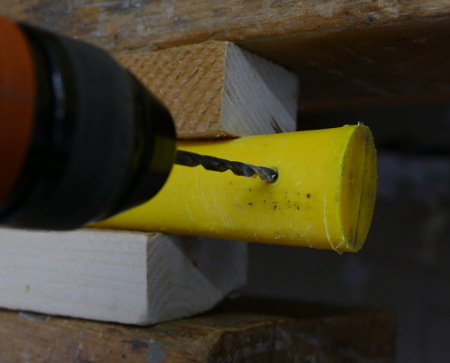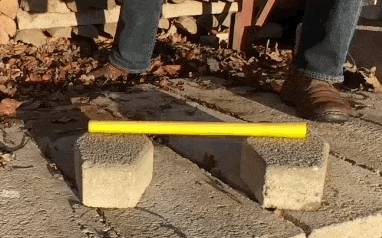
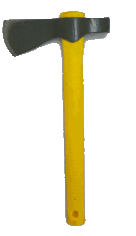
In our shop, you can buy proven fiberglass axe handles for your throwing axe!
When throwing your axe into the target round, the blade of the axe transfers all the energy straight into the wood. If a wooden axe handle hits the target end first, the head of the axe will simply take the energy, break loose and continue to "ride down" the handle, in the process sometimes putting nicks into the handle. But, if the axe is reaching the target at an angle, and maybe the handle is hitting the edge of the target, then all the energy goes right into the handle itself. Wooden handles then often break and you’ll need an axe replacement handle.
 I have been throwing axes at competitions for 15 years – and never broke one of my fiberglass axe handles! In fact, breaking a synthetic handle is very unlikely, because the axe handles made from industrial-strength plastic with their synthetic fiberglass core are designed to last. For proof, see my
I have been throwing axes at competitions for 15 years – and never broke one of my fiberglass axe handles! In fact, breaking a synthetic handle is very unlikely, because the axe handles made from industrial-strength plastic with their synthetic fiberglass core are designed to last. For proof, see my ![]() sledgehammer impact test video.
sledgehammer impact test video.
Of course, mine have some nicks from having another axe sticking in them, but that just means you should never throw two axes into the same target.
Synthetic axe handles don’t fit as tight as wood – and it’s also no use soaking plastic handles in water. To prevent the axe head from coming loose on impact – "riding down" on the handle and putting nicks into it – you’ll want to fix your synthetic handle with some screw or bolt (see instructions below). The tiny bolts included with some axe models only work for wood, though! Be sure to get longer ones that go at least halfway through the handle. That way, the head is fixed "permanently" to the replacement axe handle.
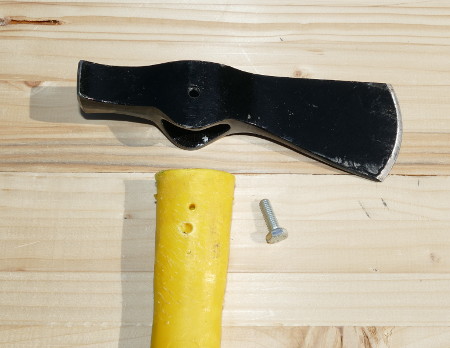
You may ask yourself if axes with a synthetic fiberglass handle do throw differently? Luckily, the answer is no, they throw the same. Plastic is somewhat denser than wood, but since you’ll be using slightly shorter synthetic handles, you won’t notice a big difference in throwing. Some numbers to support this: The original wooden handle coming with the Cold Steel Norse Hawk weighs 265g, our synthetic fiberglass handle by Steiwa weighs 263g, and a synthetic Leborgne handle weighs 273g.
Synthetic handles can be shortened to have the length fitting your personal axe throwing style. Just as with wood, a hand saw allows you to cut the handle - it will easily bite through the plastic and the fiberglass core. The handle end will only fray if you had to cut through a rubber coating. It’s that easy and cheap to have your personal fine-tuned throwing axe! For reference, see also the chapter "handle length" in Dieter Führer's "Guide to knife & axe throwing" [Dieter Führer 2014].

At axe throwing competitions in Europe, it’s perfectly OK to have synthetic handles on your throwing axes. In the ![]() European Standard Rules, synthetic handles are not even mentioned separately, putting them on par with wooden axe handles. In the USA, it depends on the organiser: Blade Aces explicitly
European Standard Rules, synthetic handles are not even mentioned separately, putting them on par with wooden axe handles. In the USA, it depends on the organiser: Blade Aces explicitly ![]() sanction synthetic handles, while
sanction synthetic handles, while ![]() IKTHOF insists on wooden ones.
IKTHOF insists on wooden ones.
Those full-metal throwing axes you sometimes see, usually made from one flat piece of steel? Their throw feels more like a knife and not like an axe. That’s why in ![]() European axe throwing competitions, you won’t get them approved.
European axe throwing competitions, you won’t get them approved.
For axe throwing, you will be much better off with a smooth axe handle, which will glide through your fist smoothly on release. Axe handles with a rubber coating, such as the ones offered by Leborgne in France, do have a tendency to stick to your palm, ruining the throw. What is more, the rubber will come loose soon after a few missed throws, and will fray heavily if you ever decide to shorten the handle.
Unfortunately, for the usual application of an axe, it is a plus if the handle sticks to your hand, so you have to be lucky to find a fiberglass axe handle sans rubber.
If the throwing axe does not stick in the target wood, it might bounce back. This is not a cool, I don’t have to walk situation, but a OMG, there’s an axe coming at me one! With wooden axe handles, you get fewer bounces, because the flight energy can get eaten up by the head coming loose and "riding down" the handle. With synthetic handles, that doesn’t happen because you’ll be fixing them tightly to the head with a bolt.
The usual safety arrangements for axes are a throwing distance of at least 4m, and a dampening ground in front of the target, such as soil or mulch. (If the axe bounces back and hits a hard ground like concrete, it might bounce towards you a second time.)
Broke the handle of your wood chopping axe? Just get a wooden replacement handle. But if you intend to throw your axe, I really recommend you get a synthetic fiberglass handle – it simply won’t break on you. Just imagine an axe handle breaking mid-competition!
There are axe models that have their plastic handle permanently fixed to the head using brackets or other mechanisms – with them, you’ll be out of luck if you ever have the need for a replacement handle. With models that have their synthetic fiberglass handle simply inserted into the axe head – like with a wooden handle – replacing the handle is a breeze, simply follow the instructions below. The only thing you need is a replacement handle with the right shape to fit the eye of the axe.
If you insist on a wooden handle – for example if you don’t intend to throw your axe – you can still try to get one that will not crack quickly when you chop some wood. A good procedure to compare woods is the ![]() Janka hardness test – but there is an easier way: The US department of agriculture has published an
Janka hardness test – but there is an easier way: The US department of agriculture has published an ![]() extensive report on strength properties of domestic wood in [USDA 1935]. In table one, you can simply look up your favourite wood, and see how it holds up to impact bending – column 22 gives you the height from which a 50-pound hammer had to be dropped to fracture the test specimen. Here now a few selected results for good wood (the higher the number the better): Ash 43 (Franzinus americana), Elm 39 (Ulmus americana), Hickory 77 (Hicoria alba). If you happen to find it in your garden,
extensive report on strength properties of domestic wood in [USDA 1935]. In table one, you can simply look up your favourite wood, and see how it holds up to impact bending – column 22 gives you the height from which a 50-pound hammer had to be dropped to fracture the test specimen. Here now a few selected results for good wood (the higher the number the better): Ash 43 (Franzinus americana), Elm 39 (Ulmus americana), Hickory 77 (Hicoria alba). If you happen to find it in your garden, ![]() Cornelian cherry (Cornus mas) is a really good replacement handle wood – Greeks used it for spears.
Cornelian cherry (Cornus mas) is a really good replacement handle wood – Greeks used it for spears.
Depending on your purpose, do have a look at other wood properties, too. For example, for chopping you will want to avoid wood like Beech that flexes too much.
Just getting any replacement handle won’t work – the shape and size of the hole in the axe head ("eye") differs too much. The big brand manufacturers simply could not agree to all adhere to the same norm, for example DIN 7249. And of course the eyes of hand forged throwing axes will have rather individual shapes. It is thus recommended to get a handle that has about the same form and proportions as the axe eye it is intended for. Make sure it’s somewhat bigger than the eye, and then use a file or microplane to fit it perfectly.
Keep in mind that the axe eye is getting wider to the top of the head, and the axe handle is getting more narrow going down, meaning you have to insert the handle into the head from above. While you are a-choppin, the head can’t fly off the handle, because the swinging action will press the narrowing eye against the swelling handle, and bound them even more tightly together.
We offer a synthetic axe handle with an elliptical shape. It fits French hatchets and the axes of the Cold Steel brand.
The Steiwa replacement handle is especially suited for throwing axes. It is manufactured in a factory in Europe that specialises in professional tools. The handle material is polypropylene, with an embedded solid core of fiberglass. Using a hand saw, the handle can be shortened to personal preferences. No rubber. I never broke a Steiwa axe handle – and there were times when I trained excessively and had quite a few misses.
The Steiwa handle has an excellent fit with the US throwing axes produced by Cold Steel – their eyes luckily all have the same shape. My favourite all-purpose throwing axe is the Cold Steel Frontier Hawk – I also use it for competitions. We include a long and sturdy bolt that fits the tapped screw hole of Cold Steel axe heads, for fixing the head "permanently" to the handle. The Steiwa handle also fits many French hatchets.
Wolfgang from Austria gave them a test drive: " The handles really are great, I have been toying around with them for a few days already (Trail Hawk and Norse Hawk). They stood up to all missed throws. Fitting the handles to the head was rather easy, and thanks to the screws provided, the axe heads simply stay put in place."
Tomáš from the Czech Republic is also happy: They are great and throw nice. (picture)
Steven from Germany came back for more handles: I'm so pleased with the handles that I had to get more for my newest axes.
If you want to use the handle with a different axe, here’s the dimensions to help you judge how well it will fit: The handle end is of elliptical shape, measuring 28 x 38 mm (1,15 x 1,5 in) on top, then tapering down. The lowest part of the handle head that is supposed to go into the axe eye measures 24 x 34 mm (0,95 x 1,34 in).
Buy this axe handle in our online shop!
| Dieter Führer, Guide to Knife & Axe Throwing, Schiffer Publishing, 2014, Read our review | |
| [USDA 1935] | L. J. Markward and T. R. C. Wilson, |
1. Get rid of the previous axe handle. Have a look if there is a head bolt to remove as well.
2. From above, put the synthetic handle into the eye of the axe head.
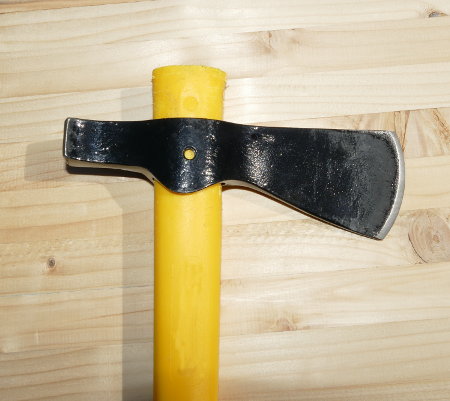
3. Put the bolt (for Cold Steel: M6, 18mm) into the tapped hole of the head. Tighten only so much as not to shear off the bolt head.
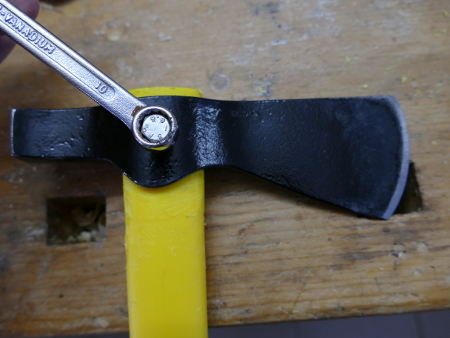
Addendum for 2.: If the axe handle does not fit tightly into the eye, get to work with a microplane file. Hit the upper end of the handle onto the floor to judge the eye fit.
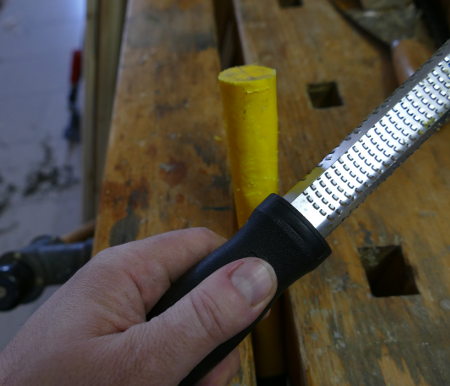
Addendum for 3.: Your handle fits tight, but there is no screw hole in the plastic beneath the bolt hole in the axe head? Make a marking, put the handle in a vice, and drill a hole (Cold Steel: 4mm) about halfway through. If you see white powder, you can stop drilling - this is already fiberglass from the core.
